DOI:
https://doi.org/10.1038/s41467-024-48676-5Skor altmetrik:
Jumlah Kutipan Dimensi:
Tahun publikasi
2024
Penulis
Zou, Y.; Zohner, C.M.; Averill, C.; Ma, H.; Merder, J.; Berdugo, M.; Bialic-Murphy, L.; Mo, L.; Brun, P.; Zimmermann, N.E.; Liang, J.; de-Miguel, S.; Nabuurs, G.-J.; Reich, P.B.; Niinements, U.; Dahlgren, J.; Kändler, G.; Ratcliffe, S.; Ruiz-Benito, P.; de Zavala, M.A.; Abegg, M.; Adou Yao, Y.C.; Alberti, G.; Almeyda Zambrano, A.M.; Alvarado, B.V.; Alvarez-Dávila, E.; Alvarez-Loayza, P.; Alves, L.F.; Ammer, C.; Antón-Fernández, C.; Araujo-Murakami, A.; Arroyo, L.; Avitabile, V.; Aymard, G.A.; Baker, T.R.; Bałazy, R.; Banki, O.; Barroso, J.G.; Bastian, M.L.; Bastin, J.-F.; Birigazzi, L.; Birnbaum, P.; Bitariho, R.; Boeckx, P.; Bongers, F.; Bouriaud, O.; Brancalion, P.H.S.; Brandl, S.; Brearley, F.Q.; Brienen, R.; Broadbent, E.N.; Bruelheide, H.; Bussotti, F.; Gatti, R.C.; César, R.G.; Cesljar, G.; Chazdon, R.; Chen, H.Y.H.; Chisholm, C.; Cho, H.; Cienciala, E.; Clark, C.; Clark, D.; Colletta, G.D.; Coomes, D.A.; Valverde, F.C.; Corral-Rivas, J.J.; Crim, P.M.; Cumming, J.R.; Dayanandan, S.; de Gasper, A.L.; Decuyper, M.; Derroire, G.; DeVries, B.; Djordjevic, I.; Dolezal, J.; Dourdain, A.; Obiang, N.L.E.; Enquist, B.J.; Eyre, T.J.; Fandohan, A.B.; Fayle, T.M.; Feldpausch, T.R.; Ferreira, L.V.; Finér, L.; Fischer, M.; Fletcher, C.; Fridman, J.; Frizzera, L.; Gamarra, J.G.P.; Gianelle, D.; Glick, H.B.; Harris, D.J.; Hector, A.; Hemp, A.; Hengeveld, G.; Hérault, B.; Herbohn, J.L.; Herold, M.; Hillers, A.; Honorio Coronado, E.N.; Hui, C.; Ibanez, T.; Iêda, A.; Imai, N.; Jagodziński, A.M.; Jaroszewicz, B.; Johannsen, V.K.; Joly, C.A.; Jucker, T.; Jung, I.; Karminov, V.; Kartawinata, K.; Kearsley, E.; Kenfack, D.; Kennard, D.K.; Kepfer-Rojas, S.; Keppel, G.; Khan, M.L.; Killeen, T.J.; Kim, H.S.; Kitayama, K.; Köhl, M.; Korjus, H.; Kraxner, F.; Laarmann, D.; Lang, M.; Lewis, S.L.; Lu, H.; Lukina, N.V.; Maitner, B.S.; Malhi, Y.; Marcon, E.; Marimon, B.S.; Marimon-Junior, B.H.; Marshall, A.R.; Martin, E.H.; Kucher, D.; Meave, J.A.; Melo-Cruz, O.; Mendoza, C.; Merow, C.; Mendoza, A.M.; Moreno, V.S.; Mukul, S.A.; Mundhenk, P.; Nava-Miranda, M.G.; Neill, D.; Neldner, V.J.; Nevenic, R.V.; Ngugi, M.R.; Niklaus, P.A.; Oleksyn, J.; Ontikov, P.; Ortiz-Malavasi, E.; Pan, Y.; Paquette, A.; Parada-Gutierrez, A.; Parfenova, E.I.; Park, M.; Parren, M.; Parthasarathy, N.; Peri, P.L.; Pfautsch, S.; Phillips, O.L.; Picard, N.; Piedade, M.T.T.F.; Piotto, D.; Pitman, N.C.A.; Polo, I.; Poorter, L.; Poulsen, A.D.; Poulsen, J.R.; Pretzsch, H.; Arevalo, F.R.; Restrepo-Correa, Z.; Rodeghiero, M.; Rolim, S.G.; Roopsind, A.; Rovero, F.; Rutishauser, E.; Saikia, P.; Salas-Eljatib, C.; Saner, P.; Schall, P.; Schelhaas, M.-J.; Schepaschenko, D.; Scherer-Lorenzen, M.; Schmid, B.; Schöngart, J.; Searle, E.B.; Seben, V.; Serra-Diaz, J.M.; Sheil, D.; Shvidenko, A.Z.; Silva-Espejo, J.E.; Silveira, M.; Singh, J.; Sist, P.; Slik, F.; Sonké, B.; Souza, A.F.; Miscicki, S.; Stereńczak, K.J.; Svenning, J.-C.; Svoboda, M.; Swanepoel, B.; Targhetta, N.; Tchebakova, N.; ter Steege, H.; Thomas, R.; Tikhonova, E.; Umunay, P.M.; Usoltsev, V.A.; Valencia, R.; Valladares, F.; van der Plas, F.; Van Do, T.; van Nuland, M.E.; Vasquez, R.M.; Verbeeck, H.; Viana, H.; Vibrans, A.C.; Vieira, S.; von Gadow, K.; Wang, H.-F.; Watson, J.V.; Werner, G.D.A.; Westerlund, B.; Wiser, S.K.; Wittmann, F.; Woell, H.; Wortel, V.; Zagt, R.; Zawiła-Niedźwiecki, T.; Zhang, C.; Zhao, X.; Zhou, M.; Zhu, Z.-X.; Zo-Bi, I.C.; Crowther, T.W.
Bahasa
English
Kata kunci
ecophisiology, ecosystem ecology, forest ecology, leaf development, forest conservation, tree growth


















